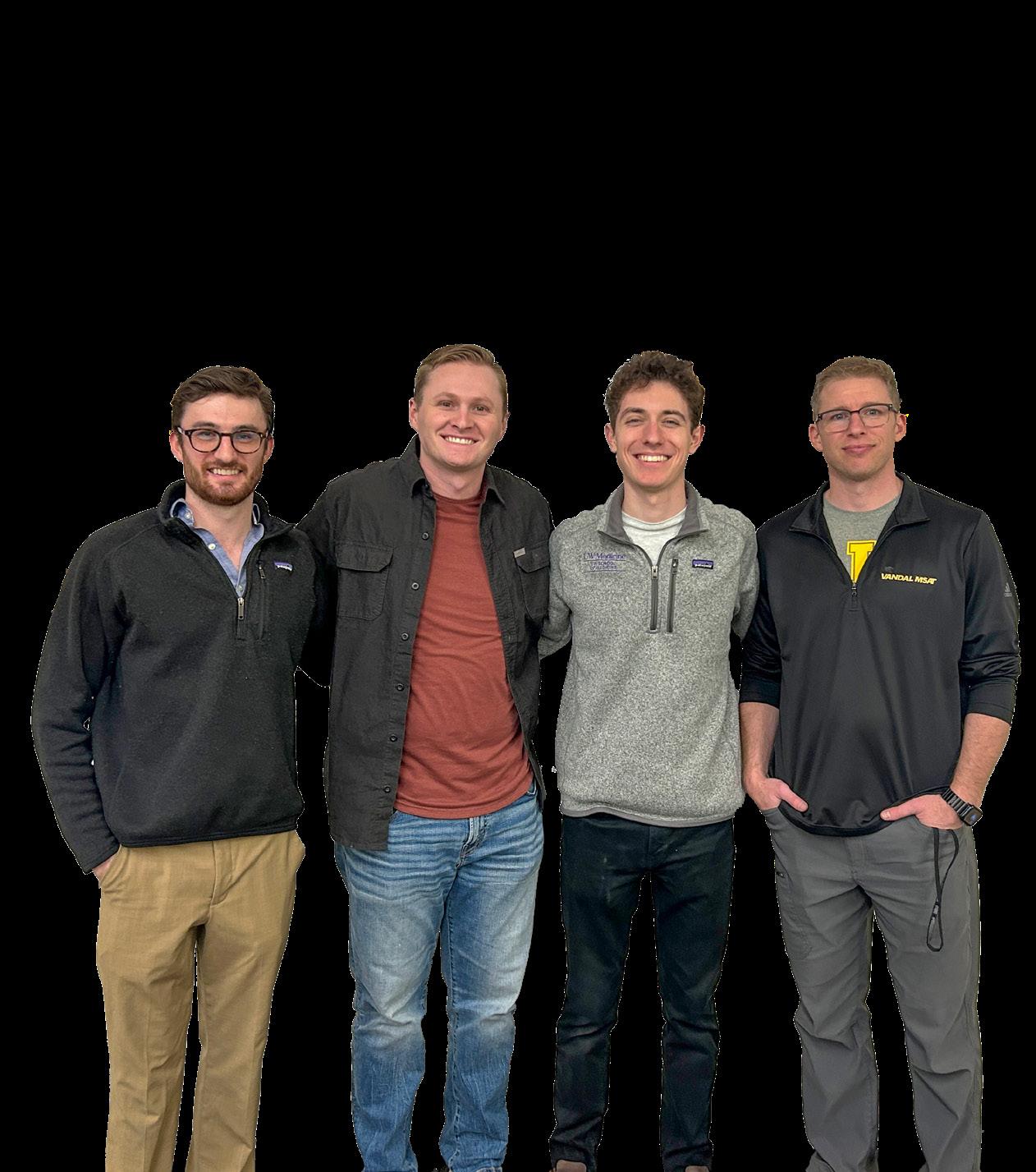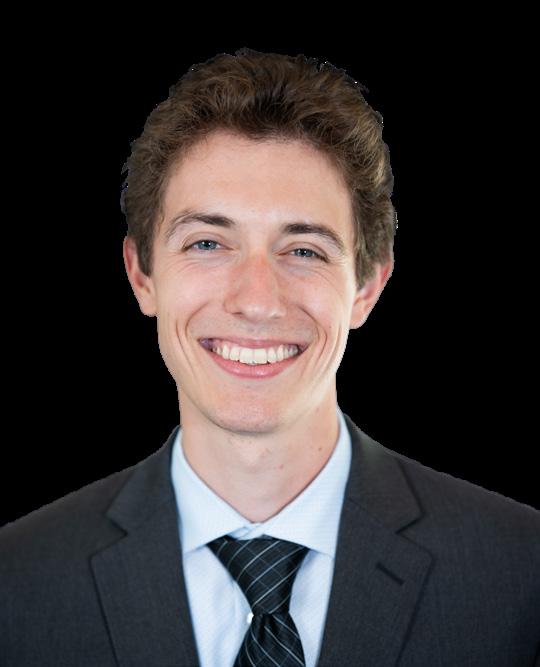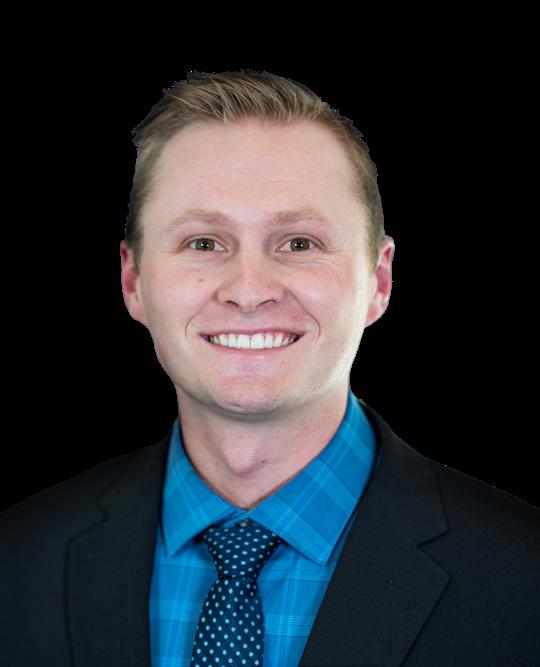
Future of Idaho WWAMI
Student Shoutouts
Idaho WWAMI Events
Research Highlights
Doc for a Day Idaho WWAMI Hosts Doc for a Day to Inspire Passion for Healthcare Careers in Young Students
In Idaho, For Idaho
WWAMI Names Research Office in Honor of Blue Cross of Idaho Foundation for Health

EXPANSION ABOUT
The D.A. Huckabay M.D. Medical Education Building is expanding! As Idaho WWAMI grows, the neccessity for more space has come to the front of everyone’s mind. This new addition will provide more space for offices, small group learning, another classroom, and a courtyard. Stay tuned for updates on the addition.
Idaho WWAMI is a partnership between the University of Washington School of Medicine and Washington, Wyoming, Alaska, Montana and Idaho (WWAMI). Since 1972, the University of Idaho has partnered with the UW School of Medicine to help train and educate Idaho’s future physicians.
 The future of Idaho WWAMI...
The future of Idaho WWAMI...

Idaho WWAMI Student Gives Back to Idaho Community
Third-year Idaho WWAMI student Jacob Menchaca took some time away from his Psychology Rotation to give back to his hometown community. Menchaca, a Pocatello native, is currently in his Psychology Rotation at State Hospital South in Blackfoot. He recently took some time off to volunteer to help build mountain biking and hiking trails on the new Pioneer Ridge loop just above Pocatello, Idaho. Menchaca graduated from ISU and hopes to practice medicine in Idaho once he graduates from Idaho WWAMI.

Second-year Idaho WWAMI student Reagan Badger, has been awarded a prestigious, highly competitive pathology fellowship.
Reagan’s dedication to a continued pursuit of pathology and immunology made her a strong candidate for this position.
Her Post-Sophomore Pathology Fellowship is a paid one-year appointment through the University of Washington.
Fellows spend the year acting as a first-year pathology resident in Seattle, working within the various hospitals covered by UW Pathology and rotating through a variety of services in anatomic and clinical pathology.
This position includes making diagnoses, writing reports, performing microscopy, grossing tissues, signing out cases with pathologists, doing autopsies, and participating in research and/or teaching.
Idaho WWAMI Medical Education Program at University of Idaho Celebrates the Future of Idaho Physicians at Their First Annual Scholarship Reception
Just nine years ago, Idaho WWAMI had only $7,000 in scholarships to award to their students.
Now, in 2023, Idaho WWAMI and their partners will award their students over $800,000 in scholarship money.
Thank you to the donors who have locked arms with us and have joined in our mission to help solve Idaho’s challenges. You are investing in the future of Idaho.
—Jeff Seegmiller, Regional Dean and Director of Idaho WWAMI
In October, Idaho WWAMI held its first annual Scholarship Reception to honor and thank their generous scholarship donors for everything they are doing to help the Idaho WWAMI mission and the future of Idaho physicians.
Over the past five years, Idaho has consistently been one of the fastest growing states in the United States, taking the number one slot in 2022 with a 1.8% population increase.
Despite this, Idaho remains



50th out of 50 in physicians per capita.
Idaho WWAMI is committed to helping solve the physician shortage in Idaho. As the only allopathic medical school in Idaho, Idaho WWAMI focuses on training medical students who are residents of Idaho to meet the needs of Idaho’s largely rural population. But they can’t do it alone.
Idaho WWAMI has been able to partner with different healthcare organizations like Blue Cross of Idaho Foundation for Health and St. Luke’s, as well as private individuals like Durward and Susan Huckabay to make this possible.
“Our students are the right people and our donors have recognized our needs,” Seegmiller said. “Thank you to our donors.”
Idaho WWAMI Hosts Doc for a Day to Inspire Passion for Healthcare Careers in Young Students
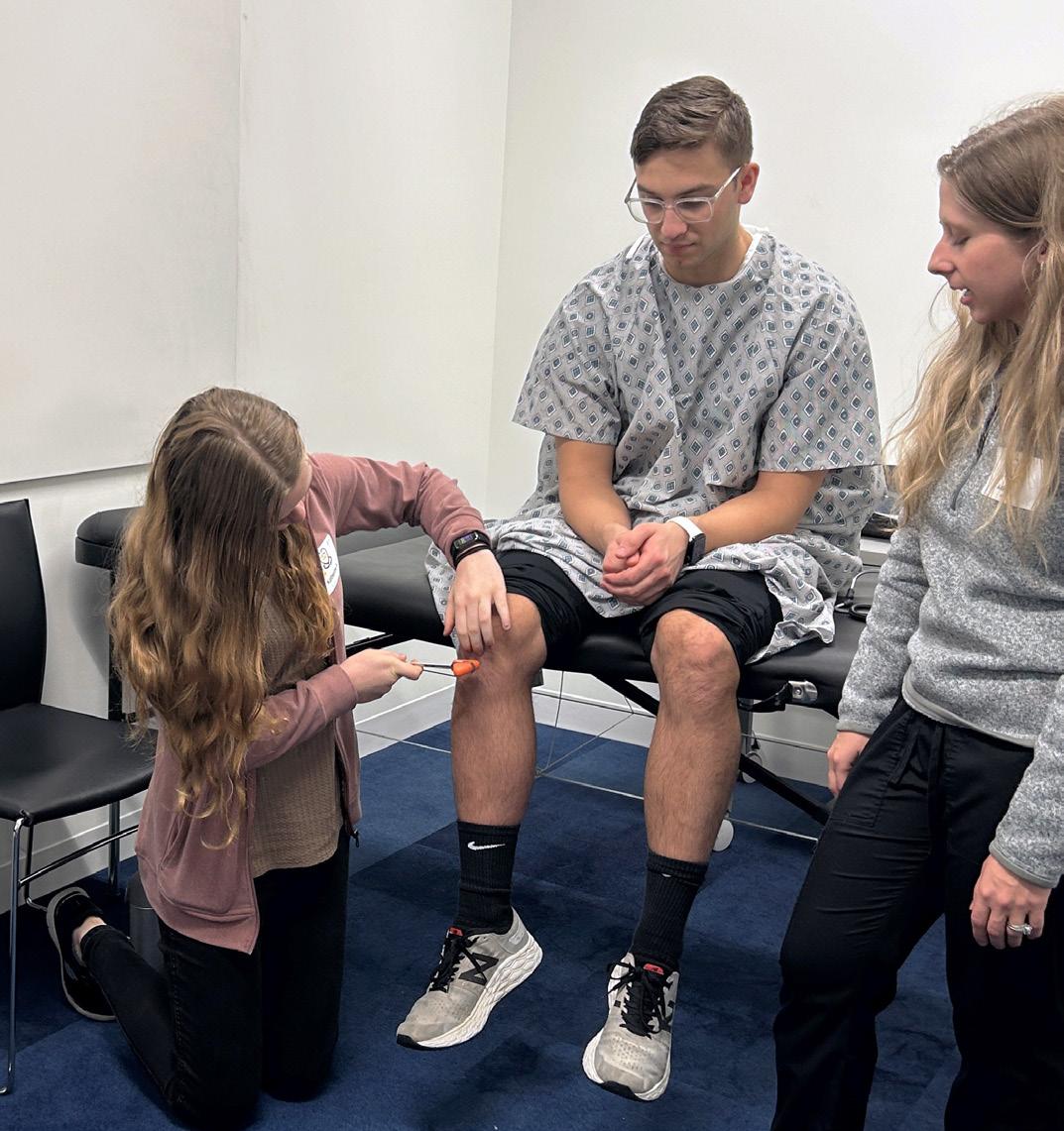
Over 30 regional middle and high school students gathered at the D.A. Huckabay Medical Education Building, in Moscow, on December 2, to attend Doc for a Day, some traveling from as far away as Cottonwood and Rathdrum.
Doc for a Day is designed to give students a handson introduction to medical school and the many different facets of medicine, with a special focus on reaching students from rural communities and/ or underrepresented backgrounds.
Idaho, despite consistently being one of the fastest growing states in the United States, is 50th out of 50 in physicians per person as of

2021. Doc for a Day hopes to inspire more students to become physicians and practice medicine in the state of Idaho.
The workshop was organized by Idaho WWAMI medical students in collaboration with the North Idaho Area Health Education Center (NI-AHEC). Medical students with varied areas of interests, including emergency medicine, anesthesiology, family medicine, ultrasound and surgical medicine worked together to coordinate interactive stations for the attendees.
Those who attended learned about the pathway to becoming a physician while practicing skills such as the basics of administering CPR, taking vitals and performing ultrasounds, among other things.
Doc for a Day provides as much hands-on experience as possible for attendees, even allowing participants to practice suturing.
Doc for a Day is an opportunity for young students to learn as much as they can about the medical industry and get a small

glimpse of what a career as a physician looks like. They are encouraged to pick the brains of the Idaho WWAMI students, asking any and every question that comes to mind, whether it’s about how they got to medical school, or what an acronym means.
The day ended with an Idaho WWAMI student panel, where Doc for a Day attendees had the chance to do just that. Participants asked them about their journey to medical school, prep classes and any advice they might have.
Without having an experience like this, you really wouldn’t know about the variety that exists within medical specialties unless you had already gone to medical school and had done your clinical rotations.
—Kaden Lee, First-Year Idaho WWAMI student
Idaho WWAMI Names Research Office in Honor of Blue Cross of Idaho Foundation for Health


The motto “We’re in Idaho for Idaho,” guides the direction of Blue Cross of Idaho Foundation for Health (BCIF) in the state, said Executive Director Kendra Witt-Doyle.
“We partner up with other entities that also have that motto of being in Idaho for Idaho,” she said. “I can’t think of any other entity in Idaho that lives and breathes that on a daily basis like Idaho WWAMI. You are here for the state, and you are here for the healthcare of the state.”
BCIF has been a leader within the state of Idaho since being formed in
2001 and has consistently invested in the Idaho WWAMI Medical Education program including medical student
Health Education Center office, said Brad Martin, director of development at Idaho WWAMI.
scholarships, the research office, Project ECHO Idaho and the North Idaho Area
Now, Idaho WWAMI has named their research office after BCIF to honor their
commitment to supporting the medical program — Blue Cross of Idaho Foundation for Health Idaho Office of Underserved and Rural Medical Research (IOURMR).
“We’re here to celebrate our relationship with BCIF and their commitment to advancing health in the state of Idaho and what they’ve done for the university,” said Torrey Lawrence, provost at University of Idaho.
Partnering with BCIF has allowed Idaho WWAMI to make immeasurable strides in their mission to improve healthcare in the state of Idaho.
“We could not do what we do here at this medical school without BCIF and the partnership that they have with us,” Martin said. “It is absolutely essential and integral to our land grant mission and what we’re trying to do here in the state.”
The state of Idaho has been suffering from a physician shortage for years now, which Idaho WWAMI has been rectifying. With their partnership with BCIF, Idaho WWAMI has been able to grow their program and make progress in their mission to educate Idaho’s future physicians.
Partnerships with philanthropic entities like BCIF transform missions into realities. From expanding the capacities of the research office, to providing scholarships to students in need, BCIF gives us hope that the future of healthcare in Idaho will be a bright one.
With the cementation of their partnership with Idaho WWAMI through the naming of the research office, we can all look forward to what new healthcare projects are on the horizon.

St. Mary’s Health and Clearwater
Valley Health
Holds Victim
Casualty Simulator
A young girl ran up the bank of the Salmon River, grabbing the hand of the first person she saw.
“Help! Help! Our raft flipped over, and my dad won’t wake up!”
Thirteen Idaho WWAMI students split up across the riverbank. Some flocked to an unconscious man’s side, a few spread out to search the tree line, while others called out for those still able to move. The victim casualty simulation was officially underway.


St. Mary’s Health and Clearwater Valley Health (SMH-CVH) hosted their seventh annual Wilderness Medicine Retreat for Idaho WWAMI students this February — a weekend of rural medical education and workshops intended to teach students the skills needed to treat people with meager supplies.
The highlight being the high-stress victim casualty simulator, where students must rush into an emergency situation and triage patients while waiting for emergency

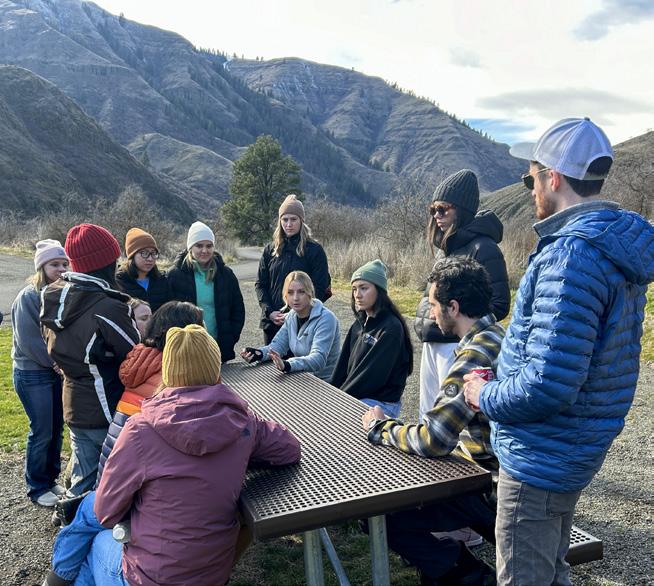


medical services (EMS) to arrive on scene.
Back on the riverbank, all of the able-bodied victims had been gathered off to the side, one girl had been treated for a leg injury, and the unconscious man’s neck was being stabilized — all in a matter of minutes.
No one was actually injured, they were all local Cottonwood citizens,
volunteering their afternoons to play victims in a rafting accident simulation designed by SMH-CVH for Idaho WWAMI students to practice their emergency rural medicine skills.
“On my count. One. Two. Three. Lift,” directed Bridget Ward, first-year medical student and group-appointed Incident Commander for this exercise.
For a lot of us, this was the first time doing this kind of thing, stepping up and doing tourniquets. I looked around, and there were people being carried out of here. I trusted you guys.
— Bridget Ward, First-Year Idaho WWAMI student


The students hoisted the unconscious man wrapped in a tarp into the air, carrying him up the sandy hill to the trailhead.
“Rock! Watch the rock behind you,” said Megan Wong, the student guiding the group up the hill.
“And scene!” called Cottonwood Police Chief Terry Cochran as the tarp was lowered onto the ground.



Physicians, Educator, Researcher: Medical Students Do It All

Those of you who are here in the white coats, it is an honor, truly, to work with you.
— Russell Baker, IOURMR Director of Medical Research

As a part of the Independent Investigative Inquiry research component of the curriculum at Idaho WWAMI, students are required to complete a summer research project, typically researching a clinical question, or completing a literature review. They present their findings during a public poster session.
Idaho WWAMI’s annual research symposium provides an opportunity for their medical students to highlight their summer research and illustrate how the findings matter in a clinical and community setting.
Research Symposium Shines a Light on Super-star Medical Students
As Idaho WWAMI continues to grow and students continue to perform research with real-life impacts, the Idaho Office of Underserved and Rural Medical Research (IOURMR), Idaho WWAMI’s research office, continues to grow alongside it.
In recent years, IOURMR has expanded the research opportunities available to students, now providing them the opportunity to do an additional, completely optional, research project during the traditional academic year and over the course of the summer.

36 years ago, Idaho WWAMI began the Rural Underserved Opportunities Program (RUOP). It has since evolved to inculude a unique research opportunity. RUOP places students in a medically underserved community in Idaho for several weeks. Students then complete an original research project relevant to the community.
One of the options pioneered at the University of Idaho is the hybrid Scholarship of Discovery Rural Underserved Opportunities Program experience. If students elect to take on the additional hybrid RUOP research opportunity, they will spend several weeks in a medically underserved community while working with the IOURMR team to complete a research project relevant to Idaho’s rural communities.
Despite RUOP being around for 36 years, the attached Scholarship of Discovery research project was piloted just two years ago with a single Idaho WWAMI student in Orofino. In 2023, 17 students chose to do the extra work to complete this hybrid research option in addition to completing their four-week immersive
clinical experience in an Idaho community as part of the RUOP.
“Medical school is hard,” said Dr. Russell Baker, IOURMR Director of Medical Research. “Students are here all the time training to become physicians. For them to sacrifice their limited free time to participate in non-required research projects to become better physicians, researchers and stewards of our knowledge so that they can serve others, how selfless was that decision?”
The Research Symposium is a chance for Idaho WWAMI students to get recognition for taking on more than what was expected of them, and to show off what they learned about the needs of the state they will be serving down the line.
Something that was really exciting, that I was not expecting, was that there was actually no difference in adverse pregnancy outcomes between women taking biologic medications and those who weren’t...

Nolde won the Outstanding Scholarship of Discovery Oral Presentation and got Honorable Mention in the Outstanding Scholarship of Discovery poster category.
Medical school is hard. Students eat, sleep and breathe the medical industry, their education and all things healthcare.
Physicians aren’t limited to doctors providing clinical care. They’re researchers and educators making a difference in the lives of their patients, and their patients’ loved ones.
Christina Nolde spent her summer studying autoimmune disease and the association with adverse pregnancy outcomes.

Nolde and her team did a retrospective study, looking at women who’d delivered children within the University of Washington system from 2003 to 2023. From there, they assessed women who were taking biologic medications — medications made from biological sources instead of chemically synthesized — and those who weren’t. They investigated the effect of those medications — in this case, medications used to combat autoimmune diseases — on adverse pregnancy outcomes.
Nolde said that she hopes that her research can be put into clinical practice and provide real-life education for women.
...which is great news because a lot of women who are pregnant or going through pregnancy episodes will stop their medications because we really don’t know what those medications do in terms of pregnancy outcomes.
— Christina Nolde, Second-YearIdaho WWAMI student
Father of Four Finds Passion in Lab’s Infant Immunology Research
Idaho WWAMI student Jordan Richter is a father of four, which is what he said inspired him to join Fehrenkamp’s lab.
Bethaney Fehrenkamp, Clinical Assistant Professor at Idaho WWAMI, runs the immunology lab, focusing specifically on preventative healthcare for mothers and babies.
Richter said. “The research that we’ve been doing looking into the developing immune systems of babies really hit home for me.”
Fehrenkamp’s lab gives students the opportunity to join her in that research, tailoring it to fit their own passions in the immunology world. Richter has been

“If we can set little kiddos up with the best healthcare from birth on, that really is prevention,” Fehrenkamp said. “I’m passionate about that.”
“The research that she does, focusing on mothers and babies — my wife, at the time, was pregnant about to have our fourth child,”
working with Fehrenkamp’s lab to research how breast milk feeding affects the immune system development of infants.
Richter’s contributions in the lab have included assisting in the measurement of the expression of specific genes, Fehrenkamp said. This data

would let the team compare gene expression patterns between different feeding methods during the early stages of development.
Ultimately, this research will shed light on the potential impacts of breast milk feeding on immune development and the subsequent health outcomes.
“I’ve been glad to be able to be part of that,” Richter said.
“I have enjoyed seeing the benefits that breastfeeding has on babies and helping them to be healthier at the beginning of their lives so they can go on to be healthy adults. This knowledge and information will not only help us now but can help throughout generations.”

